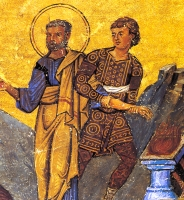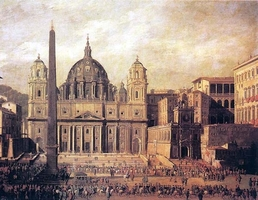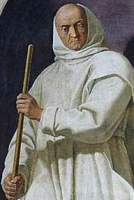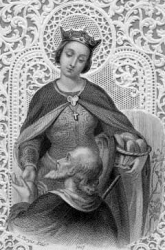St. Ermenberga
Feastday: November 19
Death: 700
Wife of Merewald, a king of Mercia, England, and the mother of Sts. Mildred, Milburga, Ermengytha, and Mildgytha. She is also known as Domna Ebba or Domneva. Ermenberga founded the convent of Minster, on Thanet Isle, on land donated by her uncle King Egbert of Kent. Egbert had murdered Ermenberga's two brothers and provided the land as atonement for his crimes.
St. Raphael Kalinowski
புனிதர் ரஃபேல் கலினோவ்ஸ்கி
போலிஷ் தீவிர கார்மேல் துறவி/ மடாலயங்களின் நிறுவனர்:
பிறப்பு: செப்டம்பர் 1, 1835
வில்னியஸ், ரஷிய பேரரசு
இறப்பு: நவம்பர் 15, 1907 (வயது 72)
வாடோவிஸ், ரஷிய பேரரசு
ஏற்கும் சமயம்:
ரோமன் கத்தோலிக்க திருச்சபை
அருளாளர் பட்டம்: கி.பி. 1983
திருத்தந்தை இரண்டாம் ஜான் பால்
புனிதர் பட்டம்: நவம்பர் 17, 1991
திருத்தந்தை இரண்டாம் ஜான் பால்
நினைவுத் திருநாள்: நவம்பர் 19
புனிதர் ரஃபேல் கலினோவ்ஸ்கி, ரஷியாவிலிருந்து பிரிந்த போலிஷ்-லித்துவானிய ஜனநாயக குடியரசிலுள்ள (Russian partition of Polish-Lithuanian Commonwealth) “விலினியஸ்” (Vilnius) எனும் இடத்தைச் சார்ந்த ஒரு “போலிஷ் தீவிர கார்மேல் துறவி” (Polish Discalced Carmelite friar) ஆவார். ஆதி கத்தோலிக்க கார்மேல் துறவு சபையைச் சார்ந்த இவர்கள், அக்காலத்தில் பாதங்களில் காலணிகள் கூட அணியாது தம்மைத் தாமே துன்புருத்திக்கொண்டு இறை சேவை புரிந்தவர்கள் ஆவார்கள். இவர், “புனிதர் ஜோசப் கலினோவ்ஸ்கியின் ரஃபெல்” (Raphael of St. Joseph Kalinowski) என்றும் அழைக்கப்படுகிரார்.
ஆசிரியர், பொறியாளர், போர்க்கைதி, அரச ஆசிரியர், குரு ஆகிய பன்முகம் கொண்ட புனிதர் ரஃபேல் கலினோவ்ஸ்கி, ரஷிய ஒடுக்குதலின் பின்னர், போலந்து முழுதும் பல கார்மலைட் துறவு மடங்களை நிறுவியவர் ஆவார்.
இவரது இயற்பெயர் “ஜோசெஃப் கலினோவ்ஸ்கி” (Józef Kalinowski ) ஆகும். இவரது தந்தை “ஆண்ட்ரூ கலினோவ்ஸ்கி” (Andrew Kalinowski) ஒரு “துணை கண்காணிப்பாளர் கணித பேராசிரியர்” (Assistant Superintendent Professor of Mathematics) ஆவார். இவரது தாயார் “ஜோசஃபின் போலோன்ஸ்கா” (Josephine Połońska), இவர் பிறந்த சில மாதங்களிலேயே இவரையும் இவரது மூத்த சகோதரர் “விக்டரையும்” (Victor) தாயற்ற குழந்தைகளாக விட்டு மரித்துப் போனார்.
எட்டு வயதிலிருந்து கல்வி கற்க ஆரம்பித்த ரஃபேல் கலினோவ்ஸ்கி, விவசாய கல்லூரியில் கற்று பட்டம் பெற்றார். அந்நாளில் ரஷியாவில் கல்விக்கும் பணிகளுக்கும் கட்டுப்பாடுகள் இருந்தபடியால் இவர் கி.பி. 1853ல் “ரஷிய பேரரசின் இராணுவத்தில்” (Imperial Russian Army) இணைந்து பொறியியல் கற்றார். பின்னர், அங்கேயே பொறியியல் பேராசிரியராகவும் பணி புரிந்தார். பின்னர், ஒரு பொறியாளராக ரெயில்வேயை வடிவமைக்க உதவினார். கி.பி. 1862ல் ரஷிய ராணுவம் அவருக்கு கேப்டனாக பதவியுயர்வு தந்தது. இருப்பினும் அவருக்கு போலந்தின் மீதிருந்த பரிவும் அன்பும் அப்படியே இருந்தது. போலந்தின் “வில்னியஸ்” பகுதியில் போலிஷ் எழுச்சியின் "ஜனவரி கிளர்ச்சிக்கு" உதவும் பொருட்டு, 1863ம் ஆண்டு, இம்பீரியல் ரஷிய ராணுவத்திலிருந்து அவர் வெளிவந்தார்.
எவரொருவருக்கும் மரண தண்டனை கொடுப்பதில்லை என்றும் எந்தவொரு போர்க்கைதியையும் தூக்கிலிடுவதில்லை என்றும் தீர்மானித்திருந்தார். 1863ம் ஆண்டு, போலிஷ் மக்கள் ரஷியாவுக்கு எதிராக கிளர்ந்தெழுந்தபோது, ரஃபெல் அவர்களுடன் இணைந்தார்.
ஆனால் விரைவிலேயே 24 மார்ச் 1864ல் ரஷிய ராணுவத்தால் அவர் போர்க்கைதியாக சிறை பிடிக்கப்பட்டார். தப்பிப் பிழைத்த ஒருசிலரும் அடிமைத் தொழிலாளர்களாக “சைபீரியா” (Siberia) பிராந்தியத்துக்கு அனுப்பப்பட்டனர். ரஃபேல் அங்கேயே நிறுத்தி வைக்கப்பட்டார். அவரது விசுவாசம் காரணமாக, அவர் சிறைக் கைதிகளின் ஆன்மீக தலைவரானார்.
கி.பி. 1864ம் ஆண்டு, மார்ச் மாதம், 24ம் தேதி, ரஷிய அதிகாரிகள் அவரை கைது செய்தனர். ஜூன் மாதம் அவருக்கு மரண தண்டனை அறிவிக்கப்பட்டது. ரஃபெலின் குடும்பத்தினரின் தலையீட்டால் ரஷிய ராணுவம் யோசித்தது. அவர் கொல்லப்பட்டால் அவர் அரசியல் தியாகியாக மதிக்கப்படலாம் என்ற பயம் அவர்களிடையே எழுந்தது. அவருடைய மரண தண்டனையை பத்து வருட சிறைத் தண்டனையாக குறைத்தனர். சைபீரிய தொழிலாளர் முகாமுக்கு அனுப்ப தீர்மானித்தனர். அவரும் இன்னும் பல போர்க்கைதிகளும் "சைபீரியாவிலுள்ள" (Siberia) அடிமை கூலித் தொழிலாளர்களாக வலுக்கட்டாயமாக இழுத்துச் செல்லப்பட்டனர். உப்புச் சுரங்கங்களினூடே ஒன்பது மாதங்களாக பயணித்த அவர்களில் அநேகர் வழியிலேயே மரித்துப் போயினர். ஆனால், தமது இறை விசுவாசத்தின் காரணமாக உயிர் பிழைத்த ரஃபேல், அங்குள்ள சிறைக்கைதிகளின் மத தலைவராக உருவெடுத்தார். பத்து ஆண்டு சிறைவாசத்தின் பிறகே அவர் விடுவிக்கப்பட்டார்.
கி.பி. 1872ம் ஆண்டு, ரஷிய புவியியல் அமைப்பின் சைபீரிய உட்பிரிவுக்காக ரஃபெல் வளிமண்டலவியல் ஆராய்ச்சி செய்தார். கி.பி. 1873ம் ஆண்டு அவரை விடுதலை செய்த அதிகாரவர்க்கம், லித்துவானியாவிலிருந்து (Lithuania) நாடு கடத்தியது. அதன்பின் அவர் ஃபிரான்ஸின் பாரிஸ் நகருக்கு சென்றார்.
கி.பி. 1874ம் ஆண்டு, போலந்து நாட்டின் தலைநகரான “வார்சாவ்” (Warsaw) திரும்பிய ரஃபேல், அங்கே அரசவை ஆசிரியராக பணியமர்த்தப்பட்டார். பதினாறே வயதான இளவரசர் “ஆகஸ்ட் க்ஸர்டொரிஸ்கி” (Prince August Czartoryski) என்பவருக்கு கல்வி கற்பிக்கும் பணியாற்றினார். சிறிது காலத்தில், இளவரசர் காசநோயால் (Tuberculosis) பாதிக்கப்பட்டார். இளைஞனான இளவரசரின் மருத்துவத்திற்காக “ஃபிரான்ஸ்” (France), “ஸ்விட்சர்லாந்து” (Switzerland), “இத்தாலி” (Italy) மற்றும் “போலந்து” (Poland) ஆகிய நாடுகளுக்கு இளவரசருடன் ரஃபேல் உடன் சென்றார். ரஃபேல் மீது இளவரசருக்கு பெரும் அபிமானம் ஏற்பட்டிருந்தது. (பின்னாளில், இளவரசர் ஆகஸ்ட் துறவறம் பெற்று, குருத்துவ அருட்பொழிவு பெற்று ஆன்மீக பணியாற்றினார். “சலேசிய டோன் போஸ்கோ” (Salesians of Don Bosco) சபையைச் சேர்ந்த இவருக்கு, திருத்தந்தை “இரண்டாம் ஜான் பவுல்” (Pope John Paul II) 2004ம் ஆண்டு, முக்திபெறு பட்டம் வழங்கினார்.)
கி.பி. 1877ம் ஆண்டு, கலினோவ்ஸ்கி “லின்ஸ்” (Linz) நகரிலுள்ள கார்மேல் துறவியர் மடத்தில் இணைந்தார். அங்கே அவருக்கு "புனிதர் ஜோசஃபின் சகோதரர் ரஃபெல்" (Brother Raphael of St. Joseph) என்ற ஆன்மீக பெயர் சூட்டப்பட்டது.
கி.பி. 1882ம் ஆண்டு, ஆயர் "ஆல்பின் டுனாஜேவ்ஸ்கி" (Bishop Albin Dunajewski) ரஃபேலுக்கு குருத்துவ அருட்பொழிவு செய்வித்தார். 1883ல் ரஃபெல் “ஸ்செர்னா” (Czerna) நகரின் துறவியர் மடத்தின் தலைவர் ஆனார். “போலந்து” மற்றும் “உக்ரைனில்” (Poland and Ukraine) பல்வேறு கத்தோலிக்க நிறுவனங்களை நிறுவினார். கி.பி. 1884 மற்றும் 1888ல் கார்மேல் அருட்சகோதரியருக்கான துறவு மடங்களை நிறுவினார். கி.பி. 1892 முதல் 1907 வரையான காலகட்டத்தில், பதினேழாம் நூற்றாண்டின் கார்மேல் சபை துறவியான "அன்னை தெரெசா மார்ச்சொக்கா"வின் (Mother Theresa Marchocka) முக்திபேறு பட்டத்துக்கான வாழ்க்கை வரலாறு சம்பந்தமான ஆவன தயாரிப்பில் ஈடுபட்டிருந்தார்.
காசநோயால் (Tuberculosis) கடுமையாக பாதிக்கப்பட்டிருந்த ரஃபேல் கலினோவ்ஸ்கி 1907ம் ஆண்டு, "வடோவிக்" (Wadowice) நகரில் மரணமடைந்தார்.
(பின்னாளில், இவருக்கு 1983ம் ஆண்டு முக்திபேறு பட்டமும், 1991ம் ஆண்டு புனிதர் பட்டமும் வழங்கிய (கரோல் வோஜ்டிலா - Karol Wojtyła), திருத்தந்தை “இரண்டாம் ஜான் பால்” (Pope John Paul II) பதினான்கு வருடங்களின் பின்னர் அதே நகரில் பிறந்தார்.)
புனிதர் ரஃபேல் கலினோவ்ஸ்கி, “ரோமன் கத்தோலிக்கம்” (Roman Catholic) மற்றும் “ரஷிய மரபுவழி” (Russian Orthodox) ஆகிய திருச்சபைகளின் பிரபலமான ஆன்மீக வழிகாட்டியாக இருந்தார்.
Feastday: November 19
Birth: September 1, 1835
Death: November 15, 1907
Beatified: June 22, 1983, Krakow, Poland, Pope John Paul II
Canonized: November 17, 1991, St. Peter's Basilica, Rome
Rafael Kalinowski(September 1, 1835 - November 15, 1907) was a Polish Discalced Carmelite friar born as Józef Kalinowski inside the Russian partition of Polish-Lithuanian Commonwealth, in the city of Vilnius He was a teacher, engineer, prisoner of war, royal tutor, and priest, who founded many monasteries around Poland after the suppression by the Russians. He was beatified by Pope John Paul II in 1991, the first man to be so recognized in the order of the Discalced Carmelites since Saint John of the Cross.
Raphael of St. Joseph Kalinowski (Polish: Józef Kalinowski, Lithuanian: Rapolas Kalinauskas) (1 September 1835 – 15 November 1907) was a Polish Discalced Carmelite friar inside the Russian partition of Polish–Lithuanian Commonwealth, in the city of Vilnius (Russian: Вильна). He was a teacher, engineer, prisoner of war, royal tutor, and priest, who founded many Carmelite monasteries around Poland after their suppression by the Russians.
Kalinowski was canonized by Pope John Paul II in 1991, the first man to be so recognized in the Order of Discalced Carmelites since John of the Cross.
Childhood
Birth record (parish of St. John in Vilna, 226/1835)
Raphael was born Józef Kalinowski to a noble "szlachta" family in the city of Vilnius (Vilna). At the time he was born, the area was known as a Russian partition, though it had formerly been part of the Polish–Lithuanian Commonwealth. He was the second son of Andrew Kalinowski (1805–1878), an assistant superintendent professor of mathematics at the local Institute for Nobles (Instytut Szlachecki). His mother, Josephine Połońska, also a noblewoman, Leliwa coat of arms died a few months after he was born, leaving him and his older brother Victor without a mother. His father then married Josephine's sister (a practice that was not uncommon in that time), Sophie Połońska, and had three more children: Charles, Emily, and Gabriel. After Sophie died in 1845, Andrew married again, this time to the 17-year-old Sophie Puttkamer, daughter of Maryla Wereszczak (famous at the time for being written about by Adam Mickiewicz), who became mother to all of Andrew's existing children and had four more of her own: Mary, Alexander, Monica, and George.
From the age of 8, Kalinowski attended the Institute for Nobles at Vilna, and graduated with honors in 1850.[1] He next attended the School of Agriculture (Instytut Agronomiczny) at Hory-Horki, near Orsha.
Saint Mechtilde of Helfta
புனித_மெக்டில்டா (1241-1298)
நவம்பர் 19
இவர் (#StMechtildeOfHelfta) ஜெர்மனியில் உள்ள ஒரு வசதியான குடும்பத்தில் பிறந்தவர்.
இவர் பிறந்ததும், "இவர் வலுக்குறைந்தவராக இருக்கிறார். அதனால் இவர் நீண்ட நாள்களுக்கு உயிர் வாழமாட்டார்" என்று எல்லாரும் சொன்னார்கள். அப்பொழுது இவருடைய பெற்றோர்தான் இவரை ஓர் அருள்பணியாளரிடம் கொண்டு சென்று, இவருக்குத் திருமுழுக்குக் கொடுக்கச் சொல்லி இவரது உயிரைக் காப்பாற்றினர்.
இவருக்கு ஏழு வயது நடக்கும்போது இவருடைய பெற்றோர் இவரை ரோடர்ஸ்டோர்ஃப் (Rodersdorf) என்ற இடத்தில் இருந்த புனித பெனடிக்ட் துறவற மடத்தில் சேர்த்துப் படிக்க வைத்தனர். அங்கு இவர் கல்வியிலும் தாழ்ச்சியிலும் இறைப்பற்றிலும் சிறந்து விளங்கி வந்தார்.
1258 ஆம் ஆண்டு இவர் ஹில்ப்டா என்ற இடத்தில் இருந்த துறவுமடத்திற்கு மாற்றலாகிச் செல்ல வேண்டிவந்தது. அங்கு மனமுவந்து ஏற்று சென்ற இவர், ஆசிரியராகவும் பாடற்குழு தலைவராகவும் பணியாற்றினார். அந்த இடத்தில் இவருடைய மூத்த சகோதரிதான் தலைமை அருள் சகோதரியாக இருந்தார் என்பது குறிப்பிடத்தக்கது.
இதற்குப் பிறகு இவர் நவ கன்னியர்களுக்குப் பயிற்சியாளராக உயர்ந்தார். அப்பொழுது இவரிடம் பயிற்சி பெற வந்தவர்தான் புனித கெர்த்ரூத். அவருடைய உதவியுடன் The Book of Special Grace என்ற தன் வரலாற்று நூலை இவர் எழுதினார்.
இவருக்குப் பலரிடமிருந்து எதிர்ப்புகள் வந்தன; அவற்றையெல்லாம் துணிவோடு எதிர் கொண்ட இவர், மிகச் சிறந்த ஆன்மிக வழிகாட்டியாக விளங்கினார். இவரிடம் ஆலோசனை கேட்பதற்குப் பல தரப்பிலிருருந்தும் மக்கள் வந்தார்கள்.
இவ்வாறு ஆண்டவருக்குத் தன்னை முற்றிலும் அர்ப்பணித்து, நல்லதோர் ஆலோசகராக விளங்கிய இவர் 1298 ஆம் ஆண்டு இறையடி சேர்ந்தார்.
இவரிடத்தில் பார்வை குறைபாடு உள்ளவர்கள், கண்களில் பிரச்சனை உள்ளவர்கள் வேண்டிக்கொண்டால் நலம் கிடைக்கும் என்றொரு நம்பிக்கை இருக்கிறது.
Also known as
• Mechtilde of Hackeborn-Wippra
• Mechtilde of Hackenborn
• Mechtilde of Magdaburg
• Mathilda, Mathildis, Matilda, Maud, Mechthild, Mechtild, Mechtildis
Additional Memorial
26 February in some Benedictine and Cistercian monasteries
Profile
Born to a pious, powerful Thuringian noble family; her older sister was a nun. Convent-educated from age seven, Mechtilde became a nun at Rodersdorf, Switzerland. She moved to the Helfta monastery in 1258 where her sister served as abbess. Teacher and choir director at the convent school at Helfta. Visionary and mystic. Novice mistress for Saint Gertrude the Great who wrote The Book of Special Grace about Mechtilde's teachings; she was initially terrified that the book might cause trouble, but Christ appeared to her in prayer and told her not to worry. She became a much sought spiritual advisor to her sister nuns, laity and learned Dominicans. May have been the inspiration for the character Matelda in Dante's Purgatorio.
Born
c.1241 at her family's castle of Helfta near Eisleben, Saxony, Germany
Died
19 November 1298 at Helfta monastery of natural causes
Patronage
against blindess (one well-known miracle was healing the blindness of a nun)
Representation
• dove on a book
• healing a blind nun
• receiving a vision of Mary
• with Saint Gertrude the Great
Saint Ebbe of Minster-in-Thanet
Also known as
• Aebbe of Minster-in-Thanet
• Domina Aebbe
• Domneva, Ermenburga, Ermenburgh
• Lady Ebba
Profile
Daughter of Prince Eormenred of Kent, England; grand-daughter of King Edbald. Sister of Saint Ermengitha, Saint Etheldreda, Saint Ethelred, and Saint Ethelbert of Eastry. Married to King Merewalh of Magonset. Mother of Saint Mildred of Thanet, Saint Milburga, and Saint Milgitha, and a son named Merefin who died very young.
In 664, Ebbe's cousin Egbert ascended to the throne of Kent. Worried about claims to the crown by Ethelred and Ethelbert, Egbert had them murdered. He later repented of the crime, and offered Queen Ebbe compensation for the loss (weregild). Ebbe chose a gift of as much land as her tame doe could run around in one course; the king agreed, and the Isle of Thanet was chosen as the site. The king's advisor, Thunor, who had recommended the murders, accused Ebbe of witchcraft, mounted his horse, and set off in pursuit of the doe; the earth promptly opened and swallowed him. The doe circled a large plot of land, which became the site of the monastery of Minster-on-Thanet, dedicated to the Blessed Virgin; today the area is known as Ebbsfleet in memory of Ebbe. On the death of King Merewalh in 673, Ebbe entered the convent as its first abbess.
Born
7th century Kent, England
Died
19 November 694 at Minster-in-Thanet, Kent, England of natural causes
Blessed James Benfatti
Also known as
• James Benefatti
• James of Mantua
• Father of the Poor
Profile
Dominican at Mantua, Italy in 1290. Doctor of theology. Priest. Friend and brother friar with Nicholas Boccasino who later became Pope Benedict XI, and for whom James held several support offices including papal legate. Bishop of Mantua in 1303. Noted for his devotion to the poor, and his care for the sick during a plague epidemic. Rebuilt his cathedral and refurbished churches. Papal legate for Pope John XXII.
Born
late 13th century at Mantua, Italy
Died
• 19 November 1332 at Mantua, Italy of natural causes
• body found incorrupt when exhumed in 1480
• body found incorrupt when exhumed in 1604
Beatified
1859 (cultus confirmed) by Pope Pius IX
Prayers
Eternal God, you established Blessed James as a model for your flock and made him renowned for his zeal for peace and for his mercy towards your people. By his prayers and example may we be united in the truth of your word and ever ardent in your divine love. We ask this through our Lord Jesus Christ, your Son, who lives and reigns with you and the Holy Spirit, one God, for ever and ever. - General Calendar of the Order of Preachers
Pope Saint Pontian
Also known as
Pontianus
Profile
Son of Calpurnius. Chosen 18th pope in 230. Ended the schism of Hippolytus and reconciled the schismatics with the Church. Exiled with Saint Hippolytus by emperor Maximinus Thrax to Sardinia and sentenced to work in the mines, he abdicated the papacy on 28 September 235 so a new man could lead the Church.
Born
at Rome, Italy
Papal Ascension
• 21 July 230
• abdicated on 28 September 235
Died
• 235 at Sardinia from the terrible treatment received in the mines
• remains brought to Rome, Italy by Pope Saint Fabian and buried in the catacomb of Callistus
Patronage
Montaldo Scarampi, Italy
Saint Barlaam of Antioch
Profile
Uneducated Christian peasant. Jailed for his faith during the persecution of Diocletian. Brought to trial in 304, he was scourged, racked, tortured, and ordered to deny his faith; he refused. In an effort to make it look as though Barlaam were making an incense offering to an idol, the judge had the prisoner's hand covered in incense, then held over the coals of a brazier. He thought that when Barlaam flinched from the pain, the incense would fall in the fire, he could declare that Barlaam had made sacrifice, and he could be turned loose as an example. Instead, Barlaam never flinched. When his entire hand had burned off, the judge gave up and had him murdered. Martyr.
Born
Antioch
Died
304 at Caesarea, Cappadocia
Saint Simon of Mount Mercury
Also known as
Simone
Profile
Tenth century monk in Calabria, Italy. Abbot. He travelled to North Africa to obtain the relesae of some monks held captive by Muslims, he was captured himself. When the Saracens demanded that the Christian prisoners renounce their faith; when they refused, the captors prepared to beat them – and became paralyzed. Simon healed them with a prayer, and he and his brother monks were released. Late in life, Simon left his monastery to live as a hermit on Mount Mercury in Calabria.
Blessed Alexandre Planas Saurí
Profile
Deaf layman in the archdiocese of Barcelona, Spain. Member of the Salesian Cooperators whom he considered his family. Skiled sculptor. Martyred in the Spanish Civil War.
Born
31 October 1878 in Mataró, Barcelona, Spain
Died
shot on 19 November 1936 in Garraf, Barcelona, Spain
Beatified
11 March 2001 by Pope John Paul II
Blessed Eliseo García y García
Profile
Member of the Salesians of Don Bosco, joining in 1932. Martyred in the Spanish Civil War.
Born
25 August 1907 in El Manzano, Salamanca, Spain
Died
shot on 19 November 1936 in Garraf, Barcelona, Spain
Beatified
11 March 2001 by Pope John Paul II
Obadiah the Prophet
Also known as
Abdias, Abdis
Profile
Old Testament prophet whose writings are dated between the 9th and 5th centuries before Christ. Outside of the text, which announces the punishment of the enemies of Israel, nothing is known about him.
Name Meaning
servant of the Lord
Saint Nerses the Great
Profile
Educated at Cappadocia. Married a princess of the Mamikonian family. Father of Saint Isaac the Great. Catholicos in 353. When some of his proposed reforms displeased King Arshak III, Nerses was exiled until recalled in 369 by King Pap - who murdered him by poisoning 4 years later.
Died
poisoned in 373
Saint James of Sasseau
Profile
Army officer, he travelled extensively. He was eventually assigned to Gaul where he retired. Priest at Clermont, France. Benedictine monk at Bourges, France. Hermit at Sasseau, France.
Born
at Constantinople (modern Istanbul, Turkey)
Died
c.865 of natural causes
Saint Atto of Tordino
Profile
Benedictine monk. First Abbot of Tordino Abbey near Teramo, Italy in 1004.
Died
• c.1010
• pilgrims used to drink the water that dripped from the ceiling above his tomb on Pentecost
• tomb and relics have long since been destroyed
Saint Eudon of Le Puy
Also known as
Eudone, Odo
Profile
Monk and then abbot in the area of Le Puy, Aquitaine (in modern France).
Died
c.720 in the area of Le Puy, Aquitaine (in modern France)
Saint Maximus of Rome
Profile
Priest. Martyred in the persecutions of Valerian.
Died
• c.255 on the Appian Way in Rome, Italy
• interred in the catacombs of Saint Xystus, Rome
Saint Azas of Isauria
Profile
One of about 150 Christian soldiers martyred together in the persecutions of Diocletian.
Died
304 in Isauria, Asia Minor
Saint Severinus of Vienne
Profile
Martyred in the persecutions of Marcus Aurelius.
Died
martyred in 170 in Vienne, France
Saint Maximus of Caesarea
Profile
Rural itinerant bishop. Martyr.
Died
255 at Caesarea, Cappadocia (in modern Turkey)
Saint Exuperius of Vienne
Profile
Martyred in the persecutions of Marcus Aurelius.
Died
170 in Vienne, France
Saint Felician of Vienne
Profile
Martyred in the persecutions of Marcus Aurelius.
Died
170 in Vienne, France
Saint Medana
Profile
Eighth century consecrated virgin who lived most of her life in the area of Galloway, Scotland.
Born
Ireland
Saint Tuto
Also known as
Toto, Totto
Profile
Founded Ottobeuren Abbey in Ottobeuren, Germany in 764.
Died
815
Martyrs of Heraclea
Profile
Forty women, a mix of nuns, widows and other lay women, who were martyred together. No other details have come down to us.
Died
Heraclea, Thrace
Also celebrated but no entry yet
• Our Lady of Providence
• Barlaam of Caves
• Corbre of Anglesey
• David of Augsburg
• Egbert of York



































